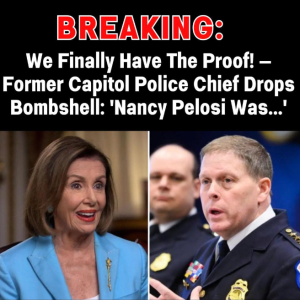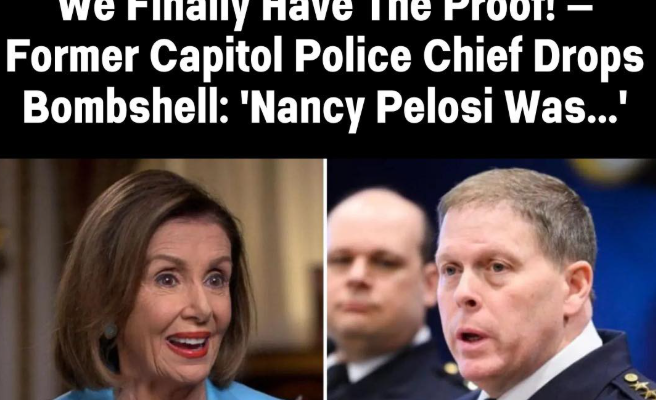 The Reckoning: Steven Sund’s Public Rebuke of Pelosi Over January 6
The Reckoning: Steven Sund’s Public Rebuke of Pelosi Over January 6
Nearly four years after the January 6 Capitol riot, the political aftershocks continue to ripple through Washington. But in August 2025, a new wave of controversy erupted when former Capitol Police Chief Steven Sund broke his silence with a blistering public rebuke of Nancy Pelosi, accusing her and her team of obstructing critical security measures in the days leading up to the attack.
In a pointed social media post, Sund wrote:
“Ma’am, it is long past time to be honest with the American people. On January 3, I requested National Guard assistance, but your Sergeant at Arms denied it… On January 6… your Sergeant at Arms again denied my urgent requests for over 70 agonizing minutes, ‘running it up the chain’ for your approval”.
The post ignited a firestorm. Sund’s words weren’t just a critique—they were a direct challenge to Pelosi’s long-standing narrative that the Trump administration bore sole responsibility for the security failures on that day. His statement reopened a bitter debate over who knew what, when, and why the Capitol was left vulnerable to one of the most shocking breaches in American history.
🧩 The Timeline Dispute
At the heart of Sund’s rebuke lies a critical timeline. According to Sund, he requested National Guard support on January 3, citing growing concerns over online chatter and intelligence suggesting potential violence. But under federal law, he couldn’t deploy the Guard without approval from the Capitol Police Board—a body that includes the House and Senate Sergeants-at-Arms, both of whom report to congressional leadership.
Sund claims his requests were denied, citing concerns over “optics.” On January 6, as rioters breached the Capitol perimeter, he again pleaded for assistance. But for over an hour, he says, his requests were stalled as officials “ran it up the chain” for Pelosi’s approval.
This version of events contradicts Pelosi’s repeated assertions that the Trump administration failed to act. In newly surfaced footage from an HBO documentary, Pelosi is seen saying, “I take responsibility,” a statement that Republicans quickly seized upon as evidence of her involvement.
🏛️ The Power Structure Behind Capitol Security
The Capitol Police Board is a little-known but powerful entity. It oversees the Capitol Police and includes the House and Senate Sergeants-at-Arms and the Architect of the Capitol. While Pelosi didn’t directly control the Capitol Police, her appointee—the House Sergeant-at-Arms—played a key role in security decisions.
Critics argue that this structure created bureaucratic paralysis. Congressman Rodney Davis noted that the Chief of Police “cannot make a final security decision without going to political appointees” and pointed to Pelosi’s office as having significant influence over those decisions.
Fact-checkers have clarified that Pelosi shared oversight responsibilities with Senate leadership and committees, and that she wasn’t solely responsible for Capitol security. But Sund’s account suggests that her team had the authority—and the opportunity—to approve Guard deployment, and failed to act.
🔥 The Fallout
Sund’s rebuke has reignited partisan tensions. House Republicans have launched renewed calls for investigations, demanding transparency about the Capitol Police Board’s decisions and Pelosi’s communications in the days before the riot. Some have called for subpoenas. Others have accused Democrats of rewriting history.
Pelosi, for her part, has maintained that the Trump administration controlled the National Guard and failed to pre-position troops. In a CNN interview, she stated: “The National Guard was the responsibility of the Trump administration to call”.
But Sund’s account complicates that narrative. He says Pentagon officials offered support, but he was legally barred from accepting without approval from congressional leadership. That approval, he claims, never came.
🎥 The Role of Media and Public Perception
The media’s role in shaping the January 6 narrative has come under renewed scrutiny. Early coverage focused heavily on Trump’s actions and rhetoric, with less attention paid to the structural failures within Capitol security. Sund’s revelations challenge that framing, suggesting that the crisis was not just a failure of leadership—but a failure of bureaucracy.
The HBO documentary footage, in which Pelosi appears to accept blame, has added fuel to the fire. Republicans argue it contradicts her earlier statements. Democrats say it shows her taking responsibility in the moment, not admitting fault for the security breakdown.
🧠 The Bigger Picture
Sund’s rebuke isn’t just about Pelosi. It’s about accountability. It’s about the systems that failed to protect the Capitol. And it’s about the lingering distrust between the public and the institutions meant to serve them.
His statement has sparked renewed calls for reform of the Capitol Police Board, greater transparency in security protocols, and a reassessment of how political influence shapes emergency response.
It also raises uncomfortable questions:
- Why were warnings ignored?
- Why did it take hours to deploy the Guard?
- And who, ultimately, bears responsibility?
🕊️ A Nation Still Healing
January 6 was a national trauma. The images of rioters storming the Capitol, lawmakers sheltering in place, and police overwhelmed by chaos are etched into the American psyche. Sund’s rebuke reopens that wound—but also offers a chance for reflection.
As the nation continues to grapple with the legacy of that day, voices like Sund’s remind us that truth is often messy, inconvenient, and politically charged. But it’s also necessary.
Whether you see Sund as a whistleblower or a scapegoat, his words demand attention. They challenge us to look beyond party lines and ask hard questions about how power is wielded—and how it can be abused.

